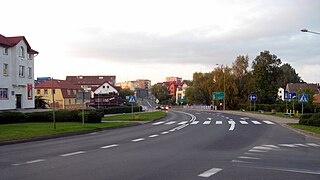Related Research Articles

During the later stages of World War II and the post-war period, Germans and Volksdeutsche fled and were expelled from various Eastern and Central European countries, including Czechoslovakia, and from the former German provinces of Lower and Upper Silesia, East Prussia, and the eastern parts of Brandenburg (Neumark) and Pomerania (Hinterpommern), which were annexed by Poland and the Soviet Union.
A Terrible Revenge: The Ethnic Cleansing of the East European Germans, 1944–1950 is a 1994 non-fiction book written by Cuban-born American lawyer Alfred-Maurice de Zayas, former research fellow at MPG in Heidelberg, Germany. The work is based on a collection of testimonials from German civilians and Wehrmacht military personnel; and devoted to the expulsion of Germans after World War II from states previously occupied by Nazi Germany. It includes as well selected interviews with British and American politicians who participated at the Potsdam Conference, including Robert Murphy, Geoffrey Harrison, and Denis Allen. The book attempts to describe the crimes committed against the German nation by the Soviet Union, Poland, Czechoslovakia, Hungary and Yugoslavia at the end of World War II – as perceived by the expellees themselves and settlers brought in Heim ins Reich from the east.
Wolf children or Little Germans were German and Prussian Lithuanian street children that existed in East Prussia at the end of World War II. Wolf children were mostly orphans left behind in the Evacuation of East Prussia and Red Army invasion in early 1945, with many living homeless in the forests of East Prussia or adopted by Lithuanian families.

Miastko, is a town in the Middle Pomerania region of northern Poland, administratively located in the Bytów County in the Pomeranian Voivodeship.

Erika Steinbach is a German right-wing politician. She previously served as a member of the Bundestag from 1990 until 2017.

Robert Menasse is an Austrian writer.

The evacuation of East Prussia was the movement of German civilian population and military personnel from East Prussia between 20 January and March 1945, that was initially organized and carried out by state authorities but quickly turned into a chaotic flight from the Red Army.

Forced labor of Germans in the Soviet Union was considered by the Soviet Union to be part of German war reparations for the damage inflicted by Nazi Germany on the Soviet Union during the Axis-Soviet campaigns (1941–1945) of World War II. Soviet authorities deported German civilians from Germany and Eastern Europe to the USSR after World War II as forced laborers, while ethnic Germans living in the USSR were deported during World War II and conscripted for forced labor. German prisoners of war were also used as a source of forced labor during and after the war by the Soviet Union and by the Western Allies.

Eberhard Esche was a German film and television actor. He studied at the Theaterhochschule Leipzig.

Demographic estimates of the flight and expulsion of Germans have been derived by either the compilation of registered dead and missing persons or by a comparison of pre-war and post-war population data. Estimates of the number of displaced Germans vary in the range of 12.0–16.5 million. The death toll attributable to the flight and expulsions was estimated at 2.2 million by the West German government in 1958 using the population balance method. German records which became public in 1987 have caused some historians in Germany to put the actual total at about 500,000 based on the listing of confirmed deaths. The German Historical Museum puts the figure at 600,000 victims and says that the official figure of 2 million did not stand up to later review. However, the German Red Cross still maintains that the total death toll of the expulsions is 2,251,500 persons.
The expulsion of Germans from Czechoslovakia after World War II was part of a series of evacuations and deportations of Germans from Central and Eastern Europe during and after World War II.
The German evacuation from Central and Eastern Europe ahead of the Soviet Red Army advance during the Second World War was delayed until the last moment. Plans to evacuate people to present-day Germany from the territories controlled by Nazi Germany in Central and Eastern Europe, including from the former eastern territories of Germany as well as occupied territories, were prepared by the German authorities only when the defeat was inevitable, which resulted in utter chaos. The evacuation in most of the Nazi-occupied areas began in January 1945, when the Red Army was already rapidly advancing westward.

Reich & sexy II: Die fetten Jahre, subtitled Ihre allergrössten Erfolge is Die Toten Hosen's second compilation album, named after the first one. It was released as a single- or double-CD, in a digipak. The cover is based on the cover of Reich & sexy.

Markus Imhoof is a Swiss film director, screenwriter, theatre and opera director.
Jan Hendriks was a German film actor. He appeared in more than 80 films on screen and TV between 1950 and 1985. In 1952 he won the German Film Award as Best Male Newcomer. Between 1977–1985 he co-starred in the TV-crime-serial The Old Fox. He died in Berlin, Germany, aged 63.

Im Auftrag des Herrn... – Die Toten Hosen Live or just Im Auftrag des Herrn is the second live album by the German punk band Die Toten Hosen. The album is compiled out of concerts of the 1996 Ewig währt am längsten tour. The title is a reference to the film The Blues Brothers.

Theodor Schieder was an influential mid-20th century German historian. Born in Oettingen, Western Bavaria, he relocated to Königsberg in East Prussia in 1934 at the age of 26. [p. 56] He joined the Nazi Party in 1937. During the Nazi era, Schieder became part of a group of German conservative historians antagonistic towards the Weimar Republic. He pursued a racially-oriented social history (Volksgeschichte), and warned about the supposed dangers of Germans mixing with other nations. During this time, Schieder used ethnographic methods to justify German supremacy and expansion. He was the author of the "Memorandum of 7 October 1939", calling for Germanization of the recaptured Polish territories after the Invasion of Poland. His suggestions were later incorporated in the German Generalplan Ost. After the war, he settled in West Germany and worked at the University of Cologne.
Heinz Gottfried Nawratil was a German lawyer, legal author and human rights activist.
Ingo Haar is a German historian. He received his Master of Arts from the University of Hamburg in 1993 and his PhD in History in 1998 at the Martin Luther University of Halle-Wittenberg. His doctoral dissertation was on "Historians in Nazi Germany: the German history and the`'Ethnic struggle' in the `East'".
Karin Orth is a German historian, known for her research into the Nazi concentration camps.
References
- ↑ "Die Vertreibung aus dem Paradies". Film Portal. Retrieved 22 June 2018.
- ↑ "Die Vertreibung aus dem Paradies". Zweitausendeins. Retrieved 22 June 2018.
- ↑ "The Expulsion from Paradise". Film Affinity. Retrieved 22 June 2018.